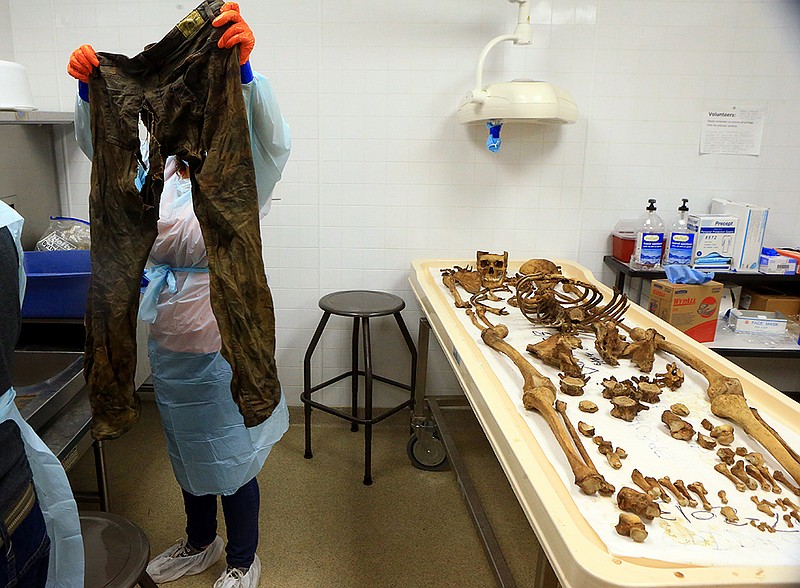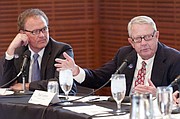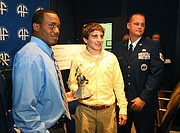SAN MARCOS, Texas-Kate Spradley was scrolling through the national database of missing people when she noticed a report contained a small detail, the color of a shirt, that made her pause.
A man Spradley calls Oscar, from El Salvador, was reported missing by a family member in Houston. He and a group of undocumented migrants circumvented the Border Patrol checkpoint in Falfurrias by trekking through sandy, rugged terrain. When Oscar was injured, another migrant tied a brown plaid shirt his leg to help him walk.
Spradley knew there was a body in the Forensic Anthropology Center at Texas State University, one of dozens of unidentified migrants exhumed from Brooks County's Sacred Heart Cemetery, that had been buried with a brown plaid shirt.
It's the type of clue Spradley, an associate professor of anthropology, and a community of volunteers spend hours painstakingly documenting in hopes of identifying people who died crossing rural Brooks County to destinations north.
While exhuming the bodies during the past two summers gives the deceased a chance to be returned to their families, it's far from the end of the journey.
Some loved ones of those who died in Brooks County already have waited years to learn what happened to their family members. The volume of cases, 90 total, mean they still have months or years left to wait.
"This is the equivalent of having a mass disaster dropped off at our lab," she told the Corpus Christi Caller-Times. "It needs to be done to give them a chance to be identified."
Spradley directs Operation Identification for the Reuniting Families project, an all-volunteer organization of forensic scientists working to return Brooks County migrant remains to their loved ones. She and Texas State University students were joined in June by volunteers from Indiana, New York and Ohio.
The reports they create-biological profiles-are needed before a DNA sample can be taken, Spradley said. The information is added to the National Missing and Unidentified Persons System.
"We consider this a humanitarian crisis just due to the sheer number," Krista Latham, associate professor of biology and anthropology at the University of Indianapolis and a Reuniting Families director.
In the classroom of the anthropology center, Latham and three University of Indianapolis graduate students took turns inspecting each bone-from the cranium to tiny bones from the toes-of each skeleton arranged on the carpet-covered table. She said each person involved gives them a chance to find an individualizing characteristic that will help family members recognize their loved one's remains.
With Latham was 33-year-old Justin Maiers, of Lapeer, Michigan. He first saw helping with the migrant grave exhumation in Brooks County as a learning opportunity, Maiers said. But volunteers have since built personal connections with the local community impacted by and responding to unidentified migrant deaths.
"To go from handling one set of remains to handling dozens at a time was almost a system overload," he said. "That's just in Brooks County. Multiply that across the border, and it's hard to wrap your brain around how huge of an issue it actually is."
In a small room down the hall, Ohio State University doctoral student Victoria Dominguez and Texas State University graduate student Lauren Meckel photographed a skeleton as part of a migrant's biological profile. While Meckel grew up in Spring, her father is from McAllen, an area heavily traveled by undocumented immigrants who travel north on U.S. Highway 281 through Brooks County.
"The idea that we can help identify some of these people whose families are looking for them brings it home for me," the 27-year-old said. "I think anthropologists have a natural instinct to want to help people, and we're lucky to be able to do what we do."
Before the skeletons and personal effects can be examined, they must be cleaned.
Four volunteers in blue protective gowns and purple latex gloves worked steadily over plastic basins and a sink in an examining room at the center, permeated by the sour, salty odor of the bodies.
Two students from Binghamton University, State University of New York campus, washed clothes the migrants wore while traveling. The garments were heavy and dark, often worn in multiple layers. Not the kinds of things the students imagined people choosing to wear in tough terrain.
"That's sad because they probably don't have any other options where they're coming from, and it's hurting them," Amy Szen, 23 of Buffalo, New York. "It's landing them here."
Szen and Susan Sincerbox, a 21-year-old from Hammondsport, New York, offered to volunteer in San Marcos after Spradley visited their university to talk about the project. They both are studying anthropology, and Sincerbox admits before arriving she wondered: "Am I going to be able to handle it?"
"It's a great opportunity to do some work that's actually going to make a difference," she said.
Personal effects of migrants are hugely important for identification, Latham said. Families remember the last thing they saw their missing relative wearing.
On a stainless steel table rested a black bra, underwear and a brown shirt with a stripe of color that indicates it may have once been red. Szen washed and added parts of an asthma inhaler.On a top shelf, they placed a black shirt, a pair of tennis shoes-size U.S. 3.5-a Guatemalan coin and a morgue tag dated July 12, 2013.
Texas State University students Eastman Barnard and Dustin Posey used toothbrushes to scrub soft tissue from vertebra. The bones would be set out to dry before being analyzed.
It can be tough at times, Eastman said, but it needs to be done.
"There's definitely a human aspect that gets to you from time to time," the 22-year-old Austin native said. "You feel like you're helping rather than memorizing more information."
As the group continued its work, Meckle broke the relative silence with the high-pitched whir of her bone saw. She planned to cut a sample from a femur until it was thin enough to allow light to pass through, then look at it under a microscope to help determine the individual's age.
"We'll have better methods of identification as a result of that," Spradley said of Meckle's research.
The science of determining age by bones was developed using skeletons of people who didn't perform a lot of manual labor, Spradley said. When applied to migrant remains found in Brooks County, "they over-age individuals." Some migrant profiles entered into the national missing persons database have age ranges of 25 to 99 years old.
It took Spradley a year and a half to fully understand how an unidentified migrant body is returned to the deceased's family. She's also learned how to troubleshoot when bureaucratic roadblocks surface.
When her team received the body of a Honduran woman, they found an ID card in her shoe and matched it to her missing person report. A positive DNA match followed. It was the team's first identification.
However, it was another year before the woman's remains were sent home. For eight months of the yearlong delay, Spradley said she tried without success to reach the Falfurrias funeral home in charge of changing the name on the death certificate.
"It's a long process, and there's lots of roadblocks, so we have to be able to think on our feet," she said.
The second match was Oscar, the man found with the brown shirt tied around his leg. The third was a man from El Salvador, identified after Spradley shared migrant DNA profiles with a forensics team in Argentina.
A DNA sample, typically from a small foot bone, is sent to the University of North Texas to be entered into a database of missing people. But that process has complications of its own. The university requires a U.S. law enforcement agent to collect a DNA sample from the migrant's family for comparison, which Spradley said means family members must travel from Central and South America to the United States."If we could cross the Argentine database with UNT, we'd probably have hundreds of matches within a week," she said.
While much of the work identifying migrants is done by forensic anthropologists, the people who have the power to reunite remains with families are Brooks County justices of the peace. The deaths occur in their jurisdictions, and they are the ones who accept or reject DNA matches.
The distance makes it tough for Spradley to reach them. Staff in the past have wrongly insisted the justices are not responsible for authorizing a body's release to foreign consulates, who send the remains home. At those times, she is assisted by Eddie Canales of the Falfurrias-based South Texas Human Rights Center.
"Eddie had been helpful in going across the street (from his office) and getting a signature," she said.
Brooks County has received state grants to recover remains and periodic assistance searching for them. But identifying the bodies falls to volunteers like Spradley, Latham and their students. They're not paid for their time. Some don't even get class credit.
"We're trying to make the policy better, but it's really hard," Spradley said. "It's the most difficult thing I've done professionally, but it's also the most professionally rewarding, working with people who care."



